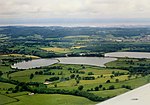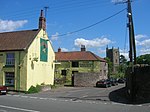Long Ashton Research Station
Long Ashton Research Station (LARS) was an agricultural and horticultural government-funded research centre located in the village of Long Ashton near Bristol, UK. It was created in 1903 to study and improve the West Country cider industry and became part of the University of Bristol in 1912. Later, it expanded into fruit research (particularly apples, pears, plums, strawberries and blackcurrants) and in the 1980s was redirected to work on arable crops and aspects of botany. It closed in 2003. The Research Station is commonly known for developing Ribena, a still-popular vitamin C-rich drink that was widely distributed in the UK during the Second World War, and the Long Ashton Nutrient Solution (LANS).
Excerpt from the Wikipedia article Long Ashton Research Station (License: CC BY-SA 3.0, Authors).Long Ashton Research Station
Blackcurrant Drive,
Geographical coordinates (GPS) Address Nearby Places Show on map
Geographical coordinates (GPS)
| Latitude | Longitude |
|---|---|
| N 51.4262 ° | E -2.6688 ° |
Address
Blackcurrant Drive
Blackcurrant Drive
BS41 9FP
England, United Kingdom
Open on Google Maps








